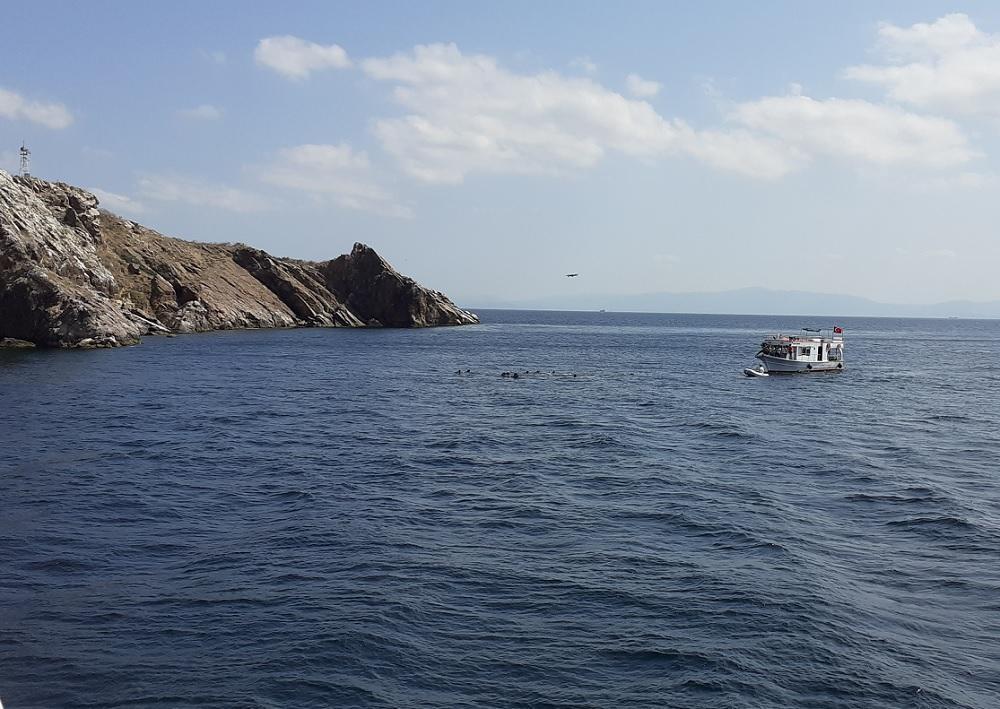
Environmental activists and academics have joined forces to revive the corals of the Princes’ Islands and create a conservation area off Istanbul’s coasts.
Marmara Sea corals suffered a mass extinction in 2015 due to a red tide coming from the Black Sea towards the Aegean Sea through Marmara Sea, an academic recalled at a press conference on Sept. 11 on a boat off the Tavşan Adası (Rabbit Island) or Neandros, the smallest of the Princes’ Islands.
“Many adverse things happened at the same time in that year. There was a serious red tide in April [2015], a plankton boom. Activities of filling the seaside with rocks and soil increased. Construction on the Princes’ Islands also peaked. The pollution from the Kurbağalıdere stream was added to those,” said Associate Prof. Nur Eda Topçu Eryalçın of Istanbul University’s Marine Biology Department.
“There are very special coral communities right here, and they have a critical influence on the function of the ecosystem. If the current conditions of rising water surface temperatures and the resulting expansion of seawater, overfishing, pollution and invasive species continue undeterred, we will be endangering these creatures and marine life as well. As a matter of fact, mass losses of up to 90 percent have been recorded in the last 20 years due to positive temperature anomalies at coralligenous reefs also including the coral species of the Princes’ Islands as one of the most important habitats of the Mediterranean,” she added.
She also stressed that most of the 24 unique coral species in the Marmara Sea, the inland sea of Turkey, have been classified as endangered or vulnerable and the sedimentation in the south of Istanbul should be monitored carefully.
Volkan Narcı, head of the Princes’ Islands Association for Life with Sea and Sports Club (ADYSK), announced the Let the Seas Teem with Life project at the press conference.
“We have successfully relocated 300 corals from the reef off the Princes’ Islands to areas around Neandros, also known as the Rabbit Island, where they can live. In addition to the coral transplantation which has been underway with a well over 90 percent success rate, we have removed thousands of square meters of ghost nets around the Princes’ Islands in order to continue our efforts to counter this silent threat for the sea world,” he said.
“Fishing nets used in the area of the Princes’ Islands are left tangled in rocks or break apart, leaving their remnants to drift in water, thereby threatening the lives of scores of marine species including corals and eventually endangering these,” he added.

Narcı called on the public and nongovernmental organization to put support behind their application to create a conservation area around Istanbul’s archipelago.
“We have been doing the plantation work. The private sector supports us. Academics and volunteers are involved in the project. But, are you aware that only one fishing net can cancel out all the works of 700 hours in five minutes?”
Roche Pharmaceuticals Turkey General Manager Natasa Klicko noted the importance of the project for Roche’s sustainable development approach.
“Our collaboration with ADYSK is based on our vision to continue all our activities with respect to ecological balance,” she said.
“We want to take this step forward for the sake of the sustainability of biological diversity in the Marmara Sea. With the trainings to be provided by ADYSK and voluntary participation of our employees, we aim to provide maximum support for the transplantation of corals to hospitable areas where no human life exists, for the removal of ghost nets, for creating awareness and for the coastal and seabed cleaning,” added Klicko.